


VOLTAIRE (FRANÇOIS-
xxxxxThe French satirist
Voltaire was the leading writer of the Enlightenment
and, as such, was a major contributor to
Diderot's Encylcopédie.
His works, including drama and poetry, covered a vast range of
subjects, the majority aimed at criticising the political and social
evils of his day -
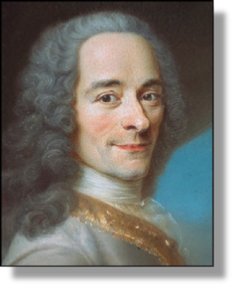 xxxxxThe French man of letters François-
xxxxxThe French man of letters François-
xxxxxHe was born in Paris and
educated at the Jesuit college of Louis le Grand, where his genius
was quickly recognised. His father, a solicitor, wanted him to study
law, but Voltaire rebelled and chose a writing career. His vitriolic
pen soon got him into a lot of trouble with the aristocracy,
including the Regent, the Duke of Orleans, and he was obliged to
spend much of his early life on the move. In 1726, following two
periods of imprisonment in the Bastille, he was banished to Engla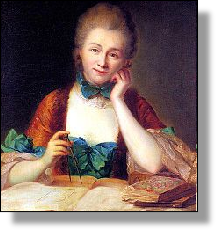 nd
where he was impressed with the country's political system, and the
comparative freedom enjoyed by its people. On his return to France
in 1729 his Philosophical Letters on the English, an oblique attack upon the
institutions of his own native land, again put him at odds with the
establishment, and in 1734 he was obliged to take refuge at the
Château de Cirey in Champagne. Here he lived with the Marquise du
Châtelet (illustrated)
-
nd
where he was impressed with the country's political system, and the
comparative freedom enjoyed by its people. On his return to France
in 1729 his Philosophical Letters on the English, an oblique attack upon the
institutions of his own native land, again put him at odds with the
establishment, and in 1734 he was obliged to take refuge at the
Château de Cirey in Champagne. Here he lived with the Marquise du
Châtelet (illustrated)
-
xxxxxDuring his time at Cirey,
he paid visits to Paris and won favour at court, largely due to the
support of the king's mistress, Madame de Pompadour, and the writing
of a number of works aimed to please, such as the La
Poème de Fontenoy, celebrating the victory
of the French over the British in 1745, a Summary
of the Age of Louis XV, and the
drama, La princess de Navarre. Such right
royal pieces earned him the position of the court historiographer,
and election to the French Academy in 1746. Three years later the
Marquise du Châtelet died, causing him much grief, and it was soon
after this that he spent two years at the court of Frederick the
Great of Prussia. The stay was not a success. Voltaire 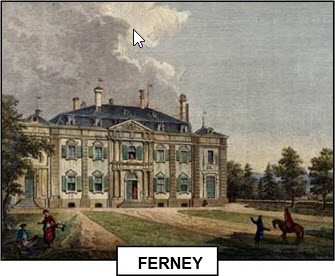 was
soon quarrelling with his host, and the visit ended abruptly in
March 1753. He then lived for a time near Geneva, but spent the last
twenty years of his life on his estate at Ferney on the Swiss
border. Some of his best work was produced there, but he also
immersed himself in local politics and championed some high-
was
soon quarrelling with his host, and the visit ended abruptly in
March 1753. He then lived for a time near Geneva, but spent the last
twenty years of his life on his estate at Ferney on the Swiss
border. Some of his best work was produced there, but he also
immersed himself in local politics and championed some high-
xxxxxVoltaire's output was phenomenal and, after his death, was made up into 70 volumes. Much of his work was propaganda in nature, a fact which, unfortunately, tended to detract from his excellent historical works, such as The Age of Louis XIV , History of Charles XII (of Sweden), and his Essay on Manners, a survey of world history from the end of the Roman Empire. A brilliant satirist with an elegant command of the written word, he was a prominent member of the reform group known as the Philosophes, and, as one would expect, a leading contributor to Diderot's Encyclopédie. His catchword was "Crush the infamous", and his formidable and various assortment of barbed attacks were directed not only against religious intolerance and the privileges enjoyed by clergy and nobles, but also against taxation, censorship of the press, and all forms of injustice. In matters of religion, he accepted the idea of a God, if only as providing a moral force in the world, but regarded God as a supreme power which, having established certain natural laws, had left man to his own devices. Politically speaking, he was an admirer of the constitutional monarchy being developed in Britain, but, for his own country he favoured an enlightened despotism, doubtless seeing it as the only workable form of government given the circumstances obtaining in France at that time.
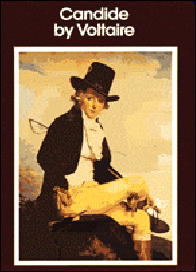 xxxxxH
xxxxxH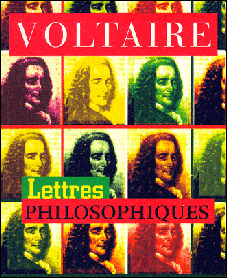 e
started of his career as a dramatist with his play Oedipus,
first performed in 1718, and followed this dazzling success with a
string of other outstanding tragedies, including Brutus,
Zara, Merope, Alzira and Mahomet.
His philosophical works -
e
started of his career as a dramatist with his play Oedipus,
first performed in 1718, and followed this dazzling success with a
string of other outstanding tragedies, including Brutus,
Zara, Merope, Alzira and Mahomet.
His philosophical works -
xxxxxA fearless champion of the oppressed and a formidable fighter for the rights of man, Voltaire's views doubtless had some bearing on the outbreak of the French Revolution, an event he clearly foresaw. As early as 1764 he wrote: "Everything I see is scattering the seeds of a revolution, which will come inevitably". It came just eleven years after his death.
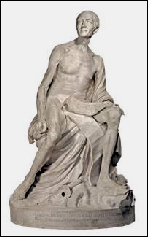 xxxxxIncidentally,
while in the Bastille, Voltaire spent much of his time composing an
epic poem entitled Henriade. Having no
paper on which to write it, he was obliged to scribble out the words
between the lines of a book. Centred around the life of the popular
French king, Henry IV -
xxxxxIncidentally,
while in the Bastille, Voltaire spent much of his time composing an
epic poem entitled Henriade. Having no
paper on which to write it, he was obliged to scribble out the words
between the lines of a book. Centred around the life of the popular
French king, Henry IV -
xxxxx……
And it was while he was in the Bastille, it would seem, that
Voltaire adopted his pen-
xxxxx......
Thexrealistic nude sculpture of the aged
Voltaire -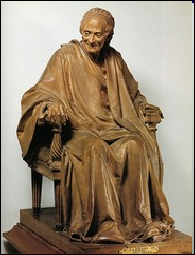 other
portraits included a life-
other
portraits included a life-
xxxxx……
The Frenchman Jean-
Acknowledgements
Voltaire:
detail, after the French painter Maurice Quentin de la Tour (1704-
G2-


